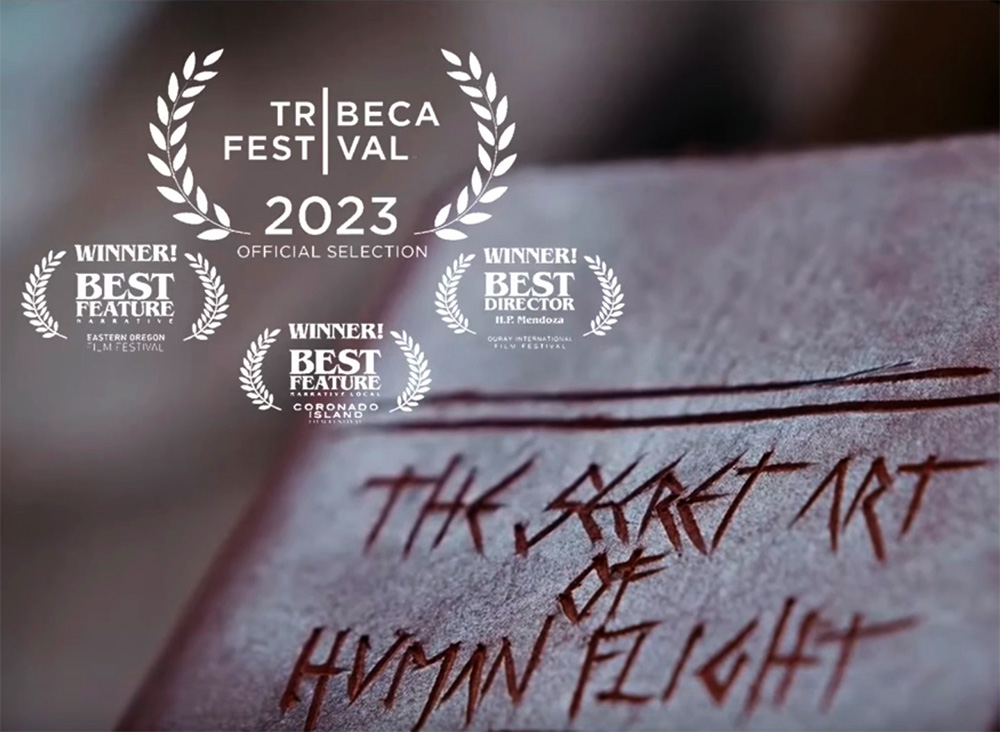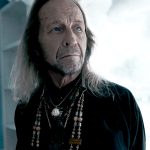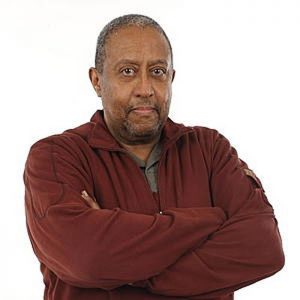THE SECRET ART OF HUMAN FLIGHT publicity paraphernalia – some, not all – describe the film as a comedy-drama about a New England widower who tries to overcome the grief of his wife’s death by hooking up with an eccentric, evangelizing, touched-in-the-head, self-proclaimed guru who says he can teach people to fly.
This reviewer, cutting to the chase, says, SECRET ART OF HUMAN FLIGHT is a cinematic tour de force that will have audience members resonating with emotion for days and days after they’ve seen the film. This reviewer had to read H.P. Mendoza’s Director’s Statement to try to know more than usual why this film was made and why it affected me so much. It literally and figuratively had me soaring every time I watched it in the course of writing the review. I’ve watched it three times – so far, and should be more than a good alert for audience members considering seeing this film based on the review article.
{PLEASE NOTE: A director’s statement is a written description explaining a film director’s motive and vision behind making a particular film. It is usually included in a proposal to producers or financiers, or in press material made available for distributors, film festival programmers, journalists, and critics. Excerpts and passages from the Director’s Statement are italicized.}

Mendoza wrote in his Director’s Statement that he was in the middle of mourning two friends who had died when he first received the script. He was mourning their deaths as he worked on the film with producer Tina Carbone and Lead Actor Grant Rosenmeyer who plays Ben Grady. It was also a chance for me to spend a month storyboarding with my DP, Markus Mentzer, running around together as I would act out the film for him, shot- by-shot, like two giddy first year film students. And then, just one week before the actors would arrive on set and start shooting, I got the call from my mother: my father had died from COVID.
When this reviewer was working on his article, it felt like he was watching – not a fictional piece of work – but a semi-documentary-narrative and it was mesmerizing with its incredible plausibility and verisimilitude. It is comedic, it is humorous but I wouldn’t dare call it funny. Humans depend on humor to get them through the tight moments and worst moments of their life and everything in between. We may be seen laughing on the outside and not seen screaming and wrenching on the inside. Feelings that I felt had been kept under wraps subconsciously were being rattled by reading Mendoza’s D-Statement and watching the film.
What was to take place on the screen was to be a fictional piece about a man in incredible searing pain seeking emotional surcease by learning from a guru about how to take off from land like a bird or an airplane. But I was feeling as if I was had been somehow exposed to a cosmic blueprint about how to really take off from land like a bird or plane.

Mealworm played by Actor Paul Raci.
Director Mendoza talking about his team: We each had a different “thing” that spoke to us from Jesse Orenshein’s script. Everybody, whether cast or crew, was very forthcoming about their personal experiences with grief, loss, and family. We were all ready to shape this parable of “life after love” together and that every step of the way we had to do it with integrity and authenticity, interrogating ourselves and each other during every scene. We’d all been collectively suffering through a pandemic in isolation for over a year, and for me it became clear that the other side of “loss” was not “life,” it was connection.
He wrote that he wanted THE SECRET ART OF HUMAN FLIGHT to be a human scale adventure. A quest of the heart that doesn’t start with flight but with the will to learn how to fly. I wanted the simple Americana of FOREST GUMP (1994) but with the discerning, spiritual eye of TREE OF LIFE (2011); the mysterious quirk of Safety Not Guaranteed (2012) but with the maddening chaos of BRAZIL (1985) or PERFECT BLUE (1997). And because I believe that THE SECRET OF HUMAN FLIGHT’S Mealworm played by Paul Raci would indeed be a difficult and untrustworthy character to allow into your life, I drew inspiration from some of my favorite horror writers, most notably Stephen King.

Ben Grady played by Grant Rosenmeyer.
We shot in large format 4:3 to envelop the audience with a much taller picture than people are accustomed to. I composed a big musical score reminiscent of all of the films that make my heart soar, like E.T. or SPIRITED AWAY. And as I edited the film to the natural rhythms we all found together, I decided to linger less on words and more on emotions. My hope is that viewers can lose themselves in this story and meditate on their own lives, their own phobias and roadblocks, and their connections to other people – maybe even to the other people in the theater. And even if after viewing this film you run back into isolation for whatever reason, I hope that – for a moment – I connected with you.
Click here for Part 2

Publisher, Editor Gregg W. Morris
Can be reached at gregghc@comcast.net, profgreggwmorris@gmail.com